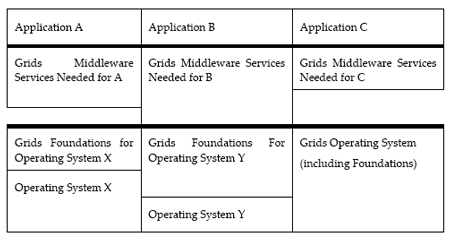|
|||
Next Generation Grids : The Work of the European Commission Expert Groupby Keith Jeffery The newly-formed European Commission Directorate General 'Infomation Society' (EC DG INFSO) Unit F2 organised a workshop to discuss the future of GRIDs in Europe in January 2003. Keynote speakers included three ERCIM researchers: Thierry Priol (INRIA), Domenico Laforenza (CNR) and the author. The workshop with over 200 attendees was a success, and it was decided to form an expert group — including the 3 keynote speakers — to take the ideas forward providing a report to the EC to assist in formulation of the later part of Framework Programme (FP) 6 and the upcoming FP7. The Next Generation GRIDs first expert group (NGG1) included also from ERCIM: Seif Haridi (SICS) Ludek Matyska (CRCIM) and Jesus Labarta (SPARCIM). The report titled 'Next Generation Grids, European Grid Research 2005-2010' was produced in the summer of 2003 and is available under http://www.cordis.lu/ist/grids. The key concept was ‘the invisible GRID’; the GRIDs environment should just ‘be there’ for use by applications in science, business, healthcare, environment, learning and culture domains. The FP6 Call2 proposals in the GRIDs area were evaluated and 4 major — CoreGRID, AkoGrimo, NextGRID and SIMDAT — and 8 smaller projects were successful; ERCIM is well represented throughout and CoreGRID (see article in this issue) is coordinated by ERCIM. These projects started officially in summer 2004, synchronized with the European GRID Technology Days, September 2004.
However, by early 2004 it was felt that projects emerging from Call2, while covering many of the issues identified in the NGG1 report, did not cover them all. Also, increasing experience of the use of middleware designed for metacomputing (connected supercomputers) in many other aspects of IT — eg massive data handling — had revealed some inadequacies. In particular, despite the welcome evolution of GRIDs middleware towards service-oriented computing — with the adoption from the World Wide Web Consortium web services the concept of grid services defined by OGSA — the architecture of current middleware did not make it easy to address major requirements of Next Generation Grids such as self-managing, self-repairing, fault-toleration and scalability. Clearly a further tranche of research topics needed to be defined. The EC reconvened an expert group (NGG2) with some of the NGG1 members (including the original 3 from ERCIM) and some new ones with a brief to produce a new report covering – with the increased knowledge of a further year – the R&D requirements as perceived now. The NGG2 report (published September 2004 available under http://www.cordis.lu/ ist/grids) is quite radical; it proposes a new architecture stack for Grids (see Figure). This stack has applications supported by middleware (like Grid services but with many new features) and in turn by foundationware on top of existing operating systems in order to enhance existing operating systems to a common interface suitable for supporting adequately Grids middleware. More dramatically, the report proposes the development of a new Grids operating system with the features of the foundationware — and possibly also the middleware — built-in in a modular, component-based fashion so that for any device (and indeed for any particular role played by a device at any one time) only the components required are loaded. The objective is a common Grids IT surface from RFID tags through sensors, embedded and control system computers, mobile phones, PDAs, laptops, desktops, departmental servers and supercomputers with massive data stores. In fact, the vision combines aspects of traditional GRID computing (metacomputing) with both distributed and P2P (peer-to-peer) architectures with many additional novel features. The key concept is the self-managing GRIDs environment with open standard interfaces to allow multiple commercial offerings. The vision requires the discarding of many long-cherished computer science principles. Global state can no longer be maintained and multiple local states with an interconnection and synchronization protocol is required – the so-called ‘soft state’ or ‘relative state’. ACID (atomicity, consistency, isolation, durability) properties of database transactions upon which almost all business depends today are no longer tenable; it is impossible to maintain, eg a lock for update across multiple self-managing nodes and so new transaction models, and new transaction compensation and recovery models, are required. The ‘classical’ notions of security are also no longer relevant; cooperating systems with different security policies and protocols will have to negotiate trust arrangements in order to provide end-to-end security (identification, authentication and authorization). Synchronisation and real-time operation is a real issue: for some applications it is essential (eg control systems) and so special protocols and guaranteed services will be required. In an environment with millions of connected nodes, intermittent and mobile communications and semantic rich messages (with linguistic and cultural heterogeneity) carried within a formally-defined syntax there are plenty of R&D challenges for information systems engineering. This vision will permit the realization of applications eg intelligent clothes, the intelligent home, the intelligently-assisted hospital, the remotely-controlled process plant, advisor systems for various aspects of life and business, environmental monitoring and control systems, enhanced lifelong e-learning, intelligent financial management, advanced scientific systems with modeling and activation of detectors, disaster management and many more – all of which are at best only part-realised without GRIDs. More importantly - and subject to trust, security and privacy - these systems will all interoperate as required, and with a common user interface structure, to weave the fabric of the knowledge society. Please contact: |
|||



